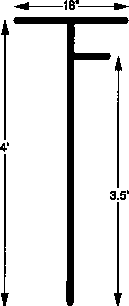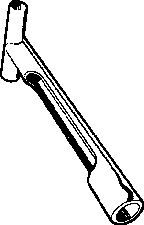Guide H-637
Esteban Herrera, Extension Horticulturist
College of Agriculture, Consumer and Environmental Sciences New Mexico State University. (Print Friendly PDF)

Fig.1.
Irrigation efficiency in pecan orchards is extremely important in the arid West where almost all the water needed come from irrigation water. Pecan trees extract the moisture they need from soil in the moist zone daily during the growing season. Pecan growers should check water penetration after each irrigation to ensure the appropriate soil moisture depth (about 3 ft after irrigating) for optimum tree growth.
A practical and quick way to measure water penetration in the orchard floor is by using 1/2" construction rod or reinforced metal bar (rebar). It should be at least 4 ft long with one end sharpened and a 1-ft piece of rod welded on at the other end (fig. 1). Another piece can be welded on one side of the rod about 3 ft from the sharp end to help to push the rod down into the soil (fig. 2).

Use the rod after all irrigation water has penetrated the orchard floor to determine if water has filled the root zone after an irrigation. About 24 hours after irrigation, push the rod down until it is impeded by dry soil. The distance the rod penetrates is depth of soil moisture penetration and should equal at least 3 ft, or the depth of the root zone. If the rod penetrates less than 3 ft, not enough water was applied during irrigation. If it goes beyond 3 ft, probably too much water was applied. In either case, the grower should make adjustments accordingly.

Growers should also check soil moisture in the orchard between irrigations. This can be done using a soil auger (fig. 3) which can be pushed down into the orchard floor at various depths. Take soil samples from the auger and feel their moisture content by gently pressing them in your hand. This can be used as a "feel test" to estimate different levels of soil moisture content. (For more information on the "feel test," refer to NMSU CES Guide 400-A111.)
By checking soil moisture before and after irrigating, pecan growers can learn more about the water-holding capacity of their pecan orchard soils, as well as the efficiency of their irrigation practices.
To find more resources for your business, home, or family, visit the College of Agricultural, Consumer and Environmental Sciences on the World Wide Web at pubs.nmsu.edu
Contents of publications may be freely reproduced for educational purposes. All other rights reserved. For permission to use publications for other purposes, contact pubs@nmsu.edu or the authors listed on the publication.
New Mexico State University is an equal opportunity/affirmative action employer and educator. NMSU and the U.S. Department of Agriculture cooperating.
February 2000, Las Cruces NM


